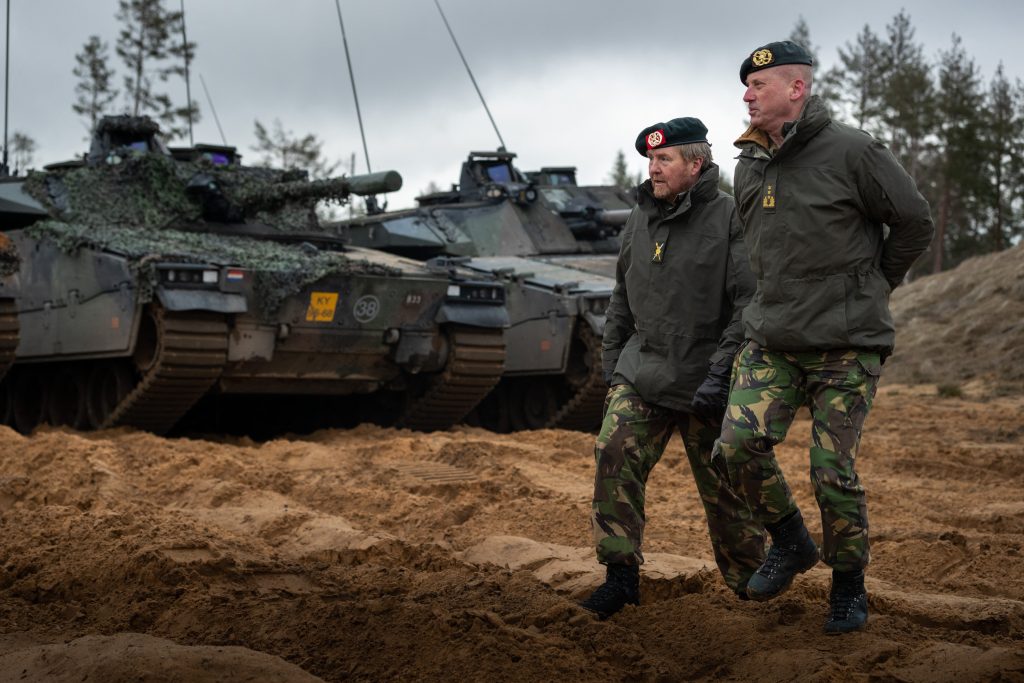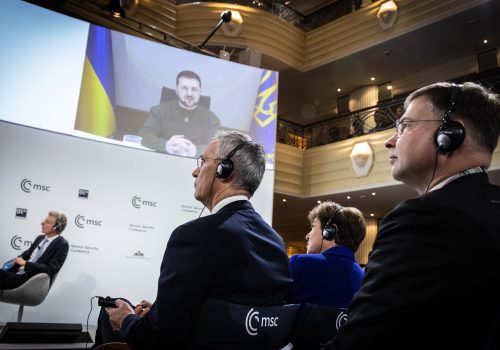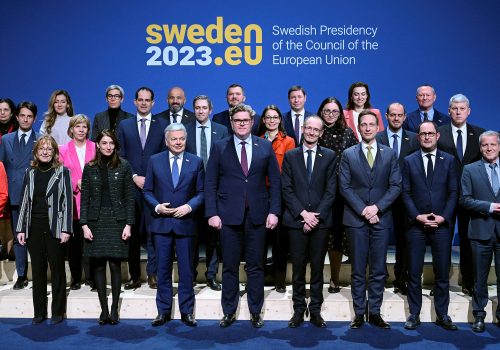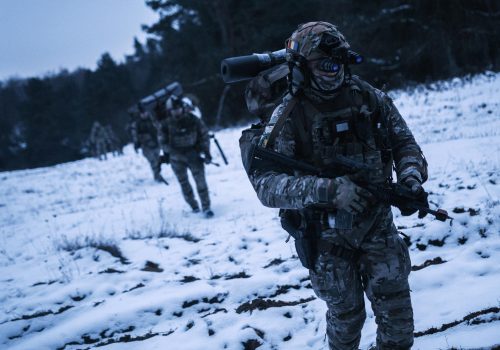Although Russia’s war against Ukraine shows no signs of ending soon, there are lessons about modern warfare generally and about the Russian way of war specifically that the West should apply now. Understanding and learning from the first large-scale armed conflict in Europe since World War II is critical at the moment, just as NATO embarks on its quadrennial defense planning effort, the Alliance finalizes regional operational plans, and leading allies devote increasing sums to national defense.
Every four years, the NATO Defence Planning Process (NDPP) begins anew, as allies strive to harmonize defense plans and ensure the timely identification, development, and delivery of interoperable forces to undertake NATO’s missions. Alliance defense ministers kicked off the latest iteration of the NDPP in February at a ministerial meeting in Brussels, when they approved political guidance for the upcoming four-year cycle. At the same time, the Alliance continues to finalize “strategic, domain-specific, and regional defense plans,” which have been under development for over a year. These plans outline how NATO will conduct operations in support of collective defense and are expected to be completed this summer. Meanwhile, Germany’s new defense minister is trying to spend the one hundred billion euros in additional funds announced in early 2022 and push for still more. French President Emmanuel Macron has announced a major increase in defense spending over the 2024-2030 budget cycle. And the United Kingdom just announced a defense spending increase of six billion pounds over the next two years. The time is ripe to examine what lessons can be drawn from the war in Ukraine and distill from those lessons the practical implications for Western military forces.
Four lessons to learn
Four key strategic and operational takeaways stand out. First, to borrow some of the words if not the exact formulation of a past Kremlin leader regarding numerical advantage, quantity lacks quality if it’s all alone. Put another way, mass without adequate training, equipment, and leadership results in exceptionally high casualties and operational failure. Moscow’s inability to capitalize on what practically all observers assessed as a quantitative overmatch of Ukrainian forces clearly caused major battlefield setbacks and has arguably prevented it from claiming victory in the war more broadly.
Second, precision can overcome mass. This lesson is the flip side of the one above. Ukraine’s reliance on more advanced, precision-guided munitions from the West helps to explain in large part why Russia’s overwhelming quantitative advantage at the war’s outset really was not that overwhelming. However, it is important to note two key caveats to this lesson—it is only true to a point when it comes to air defense, as Ukraine’s mauled critical infrastructure can attest, and it requires giving up some terrain to allow precision-guided weapons time to make an impact on an unfolding offensive.
Third, whatever stockpiles you think you need for an intense conventional fight against a near-peer, triple them. The European Union’s foreign policy chief revealed as early as September of last year that European weapon stocks were severely depleted, and things have only gotten worse since then. Meanwhile, Russia is reportedly drawing on decades-old ammunition stocks, relying on North Korean weaponry, and making devastating use of Iranian drones. The rate of equipment and ammunition usage by both sides reflects novel aspects of modern warfare—unmanned drones replacing scout troops, for instance—as well as more enduring characteristics, such as the importance of artillery and secure communications. When new characteristics are layered on older ones, as seen in Ukraine, the results will challenge even the most parsimonious quartermaster.
Fourth, having good friends matters. Certainly, Kyiv’s ability to stave off catastrophic defeat to date has primarily been due to Ukrainian will at both the popular and elite levels. But its second-most important center of gravity has been the equipment and assistance provided by the United States and the rest of NATO. Although the variety of equipment creates logistical challenges, Ukrainian forces have proven remarkably adept at maintaining and repairing all that has been provided so far, again in part due to assistance from the West. This same lesson applies within the Western alliance—the ability to share risk among allies interested in supporting Ukraine has been critical, allowing allies to move forward in unison on controversial decisions such as providing tanks.
Five ways to apply them
How do these four key strategic and operational lessons translate into action items for NATO defense planning, allied regional plans, and the defense priorities of leading member states? Several implications stand out. First, the Alliance should be content with maintaining a force posture of roughly one-to-three vis-à-vis corresponding regional Russian forces across most of the eastern flank. This generally accepted force-ratio principle holds that an attacker needs at least a three-to-one advantage to succeed over a defender. The exception, though, is the Baltic region, where the allies clearly lack any strategic depth, prospective Swedish and Finnish membership in NATO notwithstanding. Here, the allies cannot trade territory for the time necessary for precision munitions to blunt a Russian advance or for US reinforcements to arrive on the continent—and thus they will need to come closer to matching Russian forces.
Second, the larger European allies should be assigned allied defense planning targets that include building larger military force packages. To fill out the additional force structure required in the Baltic region especially, France, Germany, Italy, and the United Kingdom need to be capable of acting as first responders while US troops and materiel flow across the Atlantic. The lack of allied capacity explains much of why NATO has not already expanded its forces in the Baltic states from 1,200-person battlegroups into 4,000-person brigades. More broadly, each of these leading European allies ought to be capable of deploying and sustaining over time and distance a full corps of roughly 40,000. Admittedly, this is a very tall order given the state of allied militaries today and could take many years to achieve. At a minimum, it will require additional funding for military personnel and infrastructure—to attract enlistees with sufficient pay and benefits and to retain them with adequate standards of living and facilities.
Third, allies should ensure their political guidance emphasizes the need for NATO to engage in the kind of hybrid warfare activities that Russia has been unleashing for several years against North America and Europe. As a defensive alliance of sovereign countries, NATO has historically been far more comfortable assuming a reactive stance, but this is outmoded in a hybrid context typically playing out below the threshold of armed conflict—it leaves allies vulnerable to an aggressor’s decisive opening move. Examples of how the Alliance could make this shift in practice might include cyber or covert operations directed against Russia’s foreign-based supply chain. For instance, corrupting the software code used to produce Iranian drones could have positive impact today on the war in Ukraine and tomorrow in diminishing Russian military power over time.
Fourth, NATO should ensure it has expanded prepositioned equipment stocks both along its eastern flank but also elsewhere in Europe. These sites, perhaps in Poland and Germany as well as Sweden and Finland after they join the Alliance, ought to be sufficiently hardened against anticipated Russian missiles. Moreover, the sites should be maintained with up-to-date, interoperable equipment and ammunition, which would help European armaments manufacturers to keep production lines warm.
Finally, as the Alliance and its leading member states look to their future capabilities, they should prioritize both interoperable off-the-shelf acquisition in the short run and interoperable multilateral procurement in the long run. In other words, buy what is available from existing trusted manufacturers to meet today’s needs while aiming for grander collaborative projects in the future. The recent German decision to acquire sufficient US-made F-35 fighter jets to maintain Berlin’s role in the Alliance’s nuclear deterrence mission while preserving Germany’s commitment to the longer-term Franco-Spanish-German Future Combat Air System is a model that others might consider following.
John R. Deni is a research professor at the US Army War College’s Strategic Studies Institute and a nonresident senior fellow at the Atlantic Council’s Transatlantic Security Initative, in the Scowcroft Center for Strategy and Security. He’s the author of NATO and Article 5. The views expressed are his own.
Further reading
Fri, Feb 24, 2023
Experts react: How a year of war in Europe remade NATO, and what comes next
New Atlanticist By
The war has undeniably re-invigorated NATO. But just how much has changed? Our experts weigh in on the state of the Alliance and where allies should go from here.
Mon, Jan 30, 2023
Sweden has a chance to transform European security—even before it officially joins NATO
New Atlanticist By Franklin D. Kramer
Sweden can wield the agenda-setting powers of its presidency to push a EU security and defense budget directed toward three crucial aims: mobility, sustainment, and critical infrastructure protection.
Tue, May 17, 2022
NATO Forward Forces Tracker
Trackers and Data Visualizations By
In the lead-up to and following Russia’s invasion of Ukraine in February 2022, the United States and NATO allies have taken numerous steps to bolster allied force posture in Eastern Europe. The Scowcroft Center for Strategy and Security’s Transatlantic Security Initiative has been tracking it all. Check out its interactive table and charts to visualize the changes over time.
Image: Handout - King Willem-Alexander visits Dutch soldiers in Pabrade, Lithuania, on February 21, 2023. These are part of the NATO Enhanced Forward Presence, which aims to protect the European eastern flank. The king will participate in an exercise and will talk to the troops. Handout Photo by Robin Utrecht/ABACAPRESS.COMNo Use Netherlands. No Use Germany.



